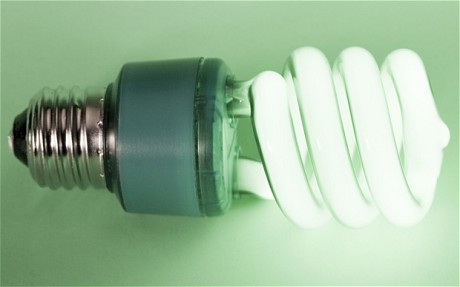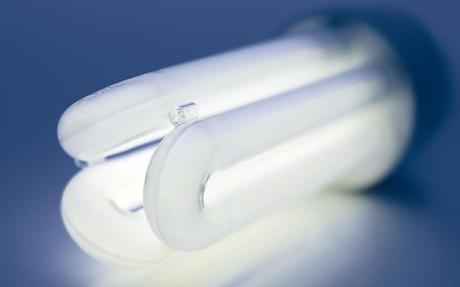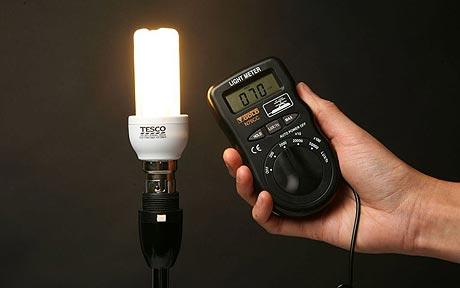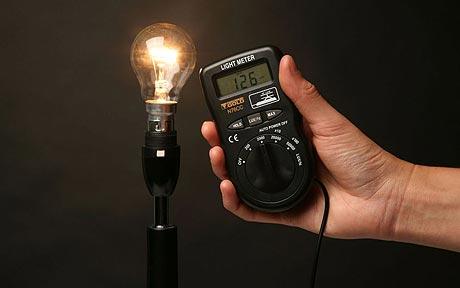|

by Victoria Ward
20 April 2011
from
Telegraph Website
|
Fears have been
reignited about the safety of energy saving light bulbs
after a group of scientists warned that they contain
cancer causing chemicals. |

Scientists claim that
several carcinogenic chemicals are released
when energy saving
light bulbs are switched on
Their report advises that the bulbs
should not be left on for extended periods, particularly near
someone’s head, as they emit poisonous materials when switched on.
Peter Braun, who carried out the tests at the Berlin's Alab
Laboratory, said:
“For such carcinogenic substances it
is important they are kept as far away as possible from the
human environment.”
The bulbs are already widely used in the
UK following EU direction to phase out traditional incandescent
lighting by the end of this year.
But the German scientists claimed that several carcinogenic
chemicals and toxins were released when the
environmentally-friendly compact fluorescent lamps (CFLs)
were switched on, including,
Andreas Kirchner, of the Federation of German Engineers,
said:
“Electrical smog develops around
these lamps.
“I, therefore, use them only very economically. They should not
be used in unventilated areas and definitely not in the
proximity of the head.”
British experts insisted that more
research was needed and urged consumers not to panic.
Dr Michelle Bloor, senior lecturer in Environmental Science
at Portsmouth University, told
the Daily Express:
“Further independent studies would
need to be undertaken to back up the presented German research.”
The Department for the Environment
insists the bulbs are safe, despite the fact that they contain small
amounts of
mercury which would leak out if the glass was broken.
Advice on its website states:
“Energy efficient light bulbs are
not a danger to the public. Although they contain mercury,
limited at 5mg per lamp, it cannot escape from a lamp that is
intact.
“In any case, the very small amount contained in an energy
efficient bulb is unlikely to cause harm even if the lamp should
be broken.”
The latest report follows claims by
Abraham Haim, a professor of biology at Haifa University in
Israel, that the bulbs could result in higher breast cancer rates if
used late at night.
He said that the bluer light that CFLs emitted closely mimicked
daylight, disrupting the body's production of the hormone melatonin
more than older-style filament bulbs, which cast a yellower light.
The Migraine Action Association has warned that they could
trigger migraines and skin care specialists have claimed that their
intense light could exacerbate a range of existing skin problems.
Energy saving light bulbs 'could
trigger breast cancer'
by Stephen Adams
Medical Correspondent
31 January 2011
from
Telegraph Website
|
Energy saving light
bulbs could result in higher breast cancer rates if used
late at night, an academic has claimed. |

Energy saving
light bulbs cast a bluer light than filament bulbs,
mimicing daylight
more closely
Abraham Haim, a professor of
biology at Haifa University in Israel, said that the bluer light
that compact fluorescent lamps (CFLs) emitted closely
mimicked daylight, disrupting the body's production of the hormone
melatonin more than older-style filament bulbs, which cast a
yellower light.
Melatonin, thought to protect against some breast and prostate
cancers, is produced and secreted by the brain's pineal gland around
the clock.
Highest secretion levels are at night but light depresses
production, even if one's eyes are shut.
A possible link between night time light exposure and breast cancer
risk has been known for over a decade, since a study was published
showing female shift workers were more likely to develop the
disease.
Prof Haim explained that a recent study by himself and fellow
colleagues had found a much stronger association than previous
research between night-time bedroom light levels and breast cancer
rates.
Their study, published in the journal Chronobiology International,
found breast cancer rates were up to 22 per cent higher in women who
slept with a light on, compared to those who slept in total
darkness.
They thought one of the reasons for this stronger link could be that
people had switched to using energy saving light-bulbs.
They wrote:
"In the past decade, light bulbs
emitting bluer light waves (~460 nm) have been widely introduced
to save energy consumption and reduce CO2 emission."
They quoted another study which showed
that exposure to bluer, shorter wavelength light for two hours in
the late evening suppressed melatonin production more than the same
exposure to yellower light (~550nm), which is more typical of
filament bulbs.
The bluer light also made people more alert and increased their body
temperature and heart rate.
Prof Haim thought this was because the bluer light from
eco-light-bulbs mimicked the stronger light of midday closer than
filament bulbs did.
Speaking to The Daily Telegraph, he said he had subsequently
removed eco-friendly light-bulbs from his house, as he thought they
caused "light pollution".
He said:
"Around the world the advice is to
change the lights to 'green' bulbs - but they are not really
green. They pollute much more light."
Because people thought they were so
cheap to run, they were turning on more lights at home, he
explained.
He emphasized that the study did not prove that using eco-friendly
light bulbs late at night or overnight resulted in higher breast
cancer rates than using filament bulbs, and that it remained an
unproven theory.
British cancer charities echoed that point.
Jessica Harris, senior health information officer at
Cancer Research UK, said:
"As this study didn’t investigate
low energy ‘eco’ light bulbs and there isn’t any other evidence
that they have an effect on breast cancer risk we can’t draw any
conclusions about the risk of breast cancer from low energy
light bulbs.
"Although it’s far from settled, the evidence that light at
night - from any source - could affect breast cancer risk is
strengthening and the World Health Organization classify shift
working as a 'probable' cause of cancer."
Dr Sarah Rawlings, head of policy
at Breakthrough Breast Cancer, said the link was "purely
speculative".
"We know there are a number of
lifestyle, genetic and environmental risk factors associated
with breast cancer, which require more research," she said.
Energy saving light bulbs offer dim
future
by Richard Gray and Julia
McWatt
29 August 2009
from
Telegraph Website
|
Energy saving light
bulbs are not as bright as their traditional
counterparts and claims about the amount of light they
produce are "exaggerated", the European Union has
admitted. |

Light meter
reading for light bulb - Energy saving light bulbs are too dim

Light Bulb Test
Soon they will be the only kind of light bulb allowed, but now
officials in Brussels have admitted that energy-saving bulbs are not
as bright as the old-fashioned kind they are replacing.
From tomorrow a Europe-wide ban on traditional incandescent bulbs
will begin to be rolled out, with a ban on 100W bulbs and old-style
frosted or pearled bulbs.
Buyers of the main type of energy-saving bulb, compact
fluorescent lamps (CFLs), are told on the packaging that they
shine as brightly as an old-fashioned bulb. For example, an 11W CFL
is labeled as being the equivalent of a 60W incandescent bulb.
However, the European Commission, which was responsible for the ban,
has now conceded that this is "not true" and that such claims by
manufacturers are "exaggerated".
The Sunday Telegraph has conducted its own tests on level of
illuminance provided by light bulbs from different manufacturers to
see whether their claims stand up to scrutiny.
We found that under normal household conditions, using a single lamp
to light a room, an 11W low-energy CFL produced only 58 per cent of
the illumination of an "equivalent" 60W bulb - even after a
10-minute "warm-up".
On a website intended to answer consumers' questions about the
switch to energy saving bulbs, the European Commission states:
"Currently, exaggerated claims are
often made on the packaging about the light output of compact
fluorescent lamps.
"For example, a 11-12 Watt compact
fluorescent lamp would be the equivalent of a 60 Watt
incandescent, which is not true. The light output of 15W compact
fluorescent lamp is slightly more than the light output from a
60W incandescent."
Under the regulations which are being
implemented in the UK from tomorrow, it will be illegal for
retailers to import 100W, frosted or pearled incandescent light
bulbs, or to sell them once their current stocks have run out.
Instead consumers will have to rely upon CFLs or low-energy halogen
bulbs.
From September 2011, 60W clear incandescent bulbs will be banned,
followed by a ban on all remaining incandescent bulbs in September
2012.
The Department for Food, Environment and Rural Affairs has
said it intends to work with retailers to begin phasing out the
traditional bulbs sooner.
Many consumers complain that CFLs take time to "warm up", are too
big for some lampshade fittings and are more expensive than the
traditional bulbs. Special CFLs costing up to £15 each are required
to work with dimmer switches.
However, the new-style bulbs use up to 80 per cent less energy than
traditional bulbs and can last far longer - up to eight years.
In our test, we used a simple lamp with a light meter placed half a
meter away, in an otherwise-darkened room, to measure the
illumination provided by a range of clear and frosted 60W
incandescent bulbs, as well as 11W CFLs said on their labels to be
equivalent.
After giving each bulb 10 minutes to warm up, a reading was taken in
lux, a measure of illumination.
Clear 60W bulbs provided around 120 lux of illumination while
pearled 60W bulbs produced 101 lux.
By comparison, the best performing energy efficient light bulb, an
11W CFL made by General Electric and handed out free to Southern
Electric customers, rated 79 lux. The worst performing 11W CFL, an
Eveready, produced just 60 lux.
A Philips Softone 12W energy saving bulb also claimed to be
equivalent to a 60W incandescent bulb, but it only produced 77 lux
of illumination.
A spokesman for Philips said that its Softone Energy Saver bulbs met
international standards and were intended to provide the equivalent
light output of a frosted incandescent bulb, but our test shows it
still failed to perform as well as a frosted bulb.
A spokesman for General Electric said all of their light bulbs were
tested to meet international standards.
She added:
“Our test results are then verified
independently before our products are approved by the Energy
Savings Trust.”
As part of the new European regulations,
manufacturers will face tough new rules on labeling, and will be
required to state their light emission in lumens as well as their
power in Watts.
Syed Kamall, the Conservative MEP who has campaigned against
European interference in traditional measures, said the new
regulations would create confusion among consumers.
He said:
"While lumens measure brightness, no
one I have met understands these units."
Ferran Tarradellas Espuny, energy
spokesman for the European Commission, said:
"The regulation is setting clear
rules on how equivalence claims with incandescent bulbs can be
made on the packaging of efficient lamps."
A spokesman for the Trading Standards
Institute, which regulates claims made about products sold in
the UK, said it was not aware of any substantiated complaints about
inaccurate labeling on low-energy bulbs.
A Defra spokesman said:
"The EU is reviewing low energy
light bulb labeling to make sure they are easily understood by
consumers and will be monitoring the accuracy of the wattage
claims."
How the energy saving bulbs compared to
incandescent bulbs
Traditional incandescent:
-
Osram 60W (700 lumens) - 126 lux
-
Philips 60 W (700 lumens) -114
lux
-
Tesco 60W (700 lumens) - 122 lux
-
Maxim Pearl 60W pearled (no
lumen info) - 101 lux
Energy Saving (all claim to be
equivalent to 60W):
-
Philips 12W T60 Softone (610
lumens) - 77 lux
-
Southern Electric/GE 11W (610
lumens) - 79 lux
-
Tesco Greener living stick 11W
(640 lumens) - 70 lux
-
Eveready Energy Saver 11W (no
lumen info) - 60 lux
-
Osram Duluxstar 11W (600 lumens)
- 67 lux
|




